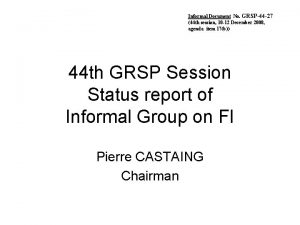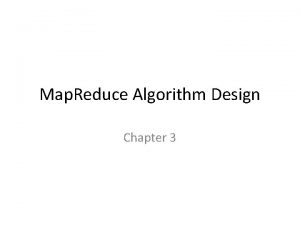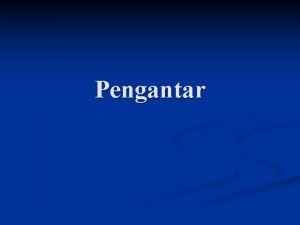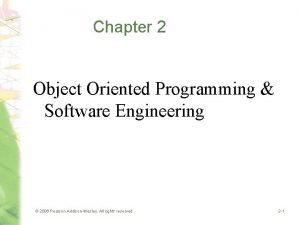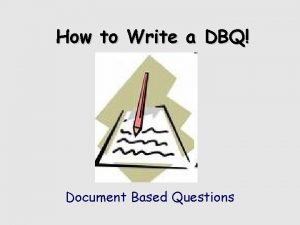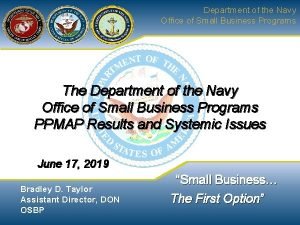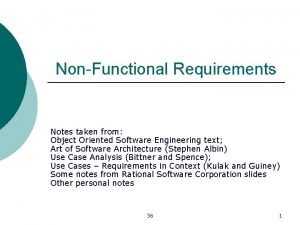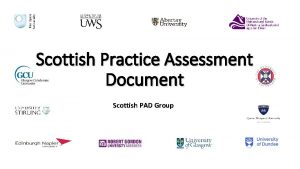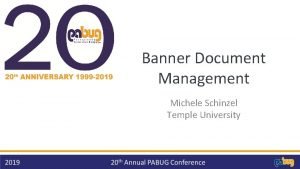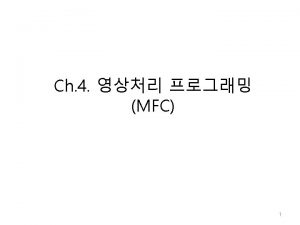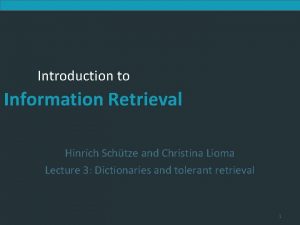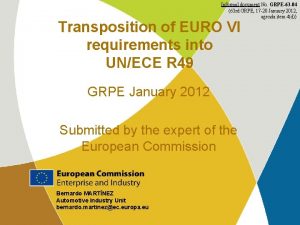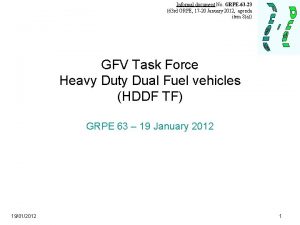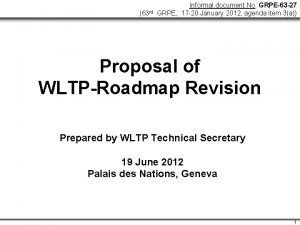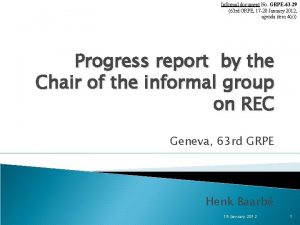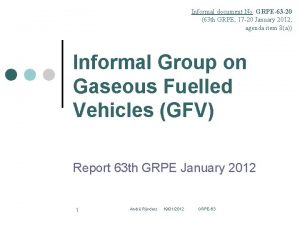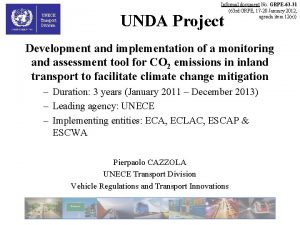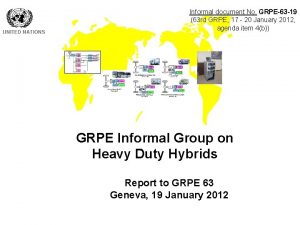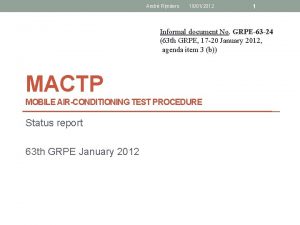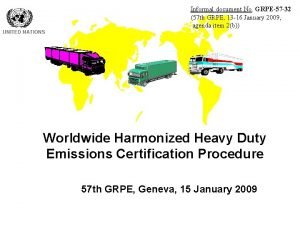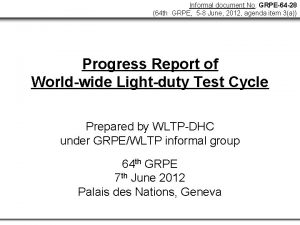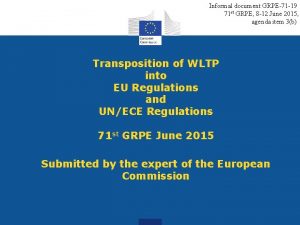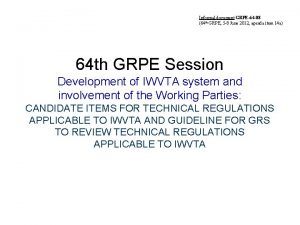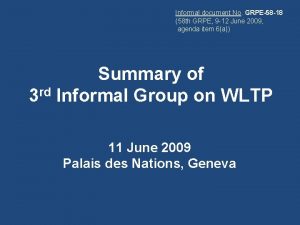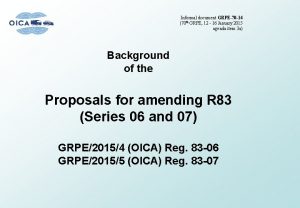Informal document No GRPE63 07 63 rd GRPE















- Slides: 15

Informal document No. GRPE-63 -07 (63 rd GRPE, 17 -20 January 2012, agenda item 11) Overview of FY 2020 Fuel Efficiency Standards for Passenger Vehicles January, 2012 Atsuto Kajiwara Ministry of Land, Infrastructure, Transport and Tourism

I. BACKGROUND 2

CO 2 Emission from transport sector in Japan CO 2 Emission from transport sector is 20% of total emission in Japan. Road transport emits 84% of transport emission. CO 2 Emission in Japan Breakdown in Transport sector Others 149 m t-CO 2 13. 0% Transport 230 m t-CO 2 20. 1% Passenger cars 115 m t-CO 2 50. 2% Private 162 m t-CO 2 14. 1% Total CO 2 emission 1, 145 m t-CO 2 (2009 fiscal year) Service/Office 216 m t-CO 2 18. 8% Industry 388 m t-CO 2 33. 9% Commercial vehicles 78 m t-CO 2 34. 1% Break down Bus/coach 4. 2 m t-CO 2 (1. 8%) Taxi 3. 9 m t-CO 2 (1. 7%) Short sea 11 m t-CO 2 (4. 6%) Aviation 10 m t-CO 2 (4. 3%) Railway 8 m t-CO 2 (3. 3%) * Emission from electric generation and thermal generation are distributed to final demand sectors according to amount of consumption of each sector. * Developed by MLIT referring to “Japanese GHG Inventory report “ 3

CO 2 emission in Transport sector Emissions from passenger transport on road peaked in FY 2001. Since FY 2001, emissions from the transportation sector have been on a downward trend. Improvement of mileage of passenger vehicles - Fuel Efficiency regulation - Green Tax (Since FY 2001) 18. 2 mil. /57. 7 mil. registered vehicles are GREEN 300 FY 2010 Target 263 267 -12. 0% % +21. 0 250 Carbon dioxide emission (million t-CO 2) +1. 6% 235 217 200 Passenger vehicles . 4% +36 % +12. 7 -11. 8% 150 100 50 Other modes of transport Commercial vehicles +12. 0% +10. 8% -2. 4% -8. 9% -7. 7% -14. 1% 240 Efficiency improvement of freight road transport - Deployment of largersize trucks: 24 -25 t truck: 80, 000(FY 02) ⇢ 160, 000(FY 08) - Shift of cargo from in-house distribution to freight carriers: freight carriers/total: 77. 2% (FY 97) ⇢ 87. 4% (FY 08) 0 1991 1992 1993 1994 1995 1996 1997 1998 1999 2000 2001 2002 2003 2004 2005 2006 2007 2008 2009 2010 Emissions from freight transport on road peaked out in FY 1996 4

History of Fuel efficiency standard Japan has long history to execute FE regulation. Through this regulation, Japan’s average FE of automobile has been improving steadily. < History of Top runner fuel efficiency regulation> Published Passenger vehicle (Gasoline) 1999 Passenger vehicle (Diesel) 1999 Passenger vehicle (Gasoline and Diesel) Target year 2010 2005 2007 2015 Passenger vehicle (Gasoline and Diesel) km/L 2020 50% improvement for 20 years 2015 Toward 2020 target 2010 target FE regulation for HDV 2006 2015 5

II. FY 2020 FE STANDARDS 6

FY 2020 Fuel Efficiency Standards for PV - Japan regulates the fuel efficiency standard based on the Energy Conservation Law. - On Oct. 20, 2011, the Joint committee under MLIT and METI concluded the new standard toward FY 2020 for Passenger Vehicles. - Introducing this new standard, average FE in 2020 will be 20. 3 km/L, which corresponds to 24. 1% improvement, comparing to the actual data in FY 2009. Fuel Efficiency improvements in Passenger vehicles FY 2020 Standard will require the automotive manufacturers to improve fuel efficiency at the highest level in the world +24. 1% Impact of Fiscal / Tax incentives * These fuel efficiency values are based on JC 08 mode. 10 -15 mode values are converted to the JC 08 mode value. 7

Driving Mode - Japan adapts original driving mode to react actual traffic situation in our country. - “JC 08 mode” are used for PV in FY 2020 standard - When the WLTP is established, the FY 2020 standard will be reconsidered in the committee. CVS equipment for Diesel blower intake Emission analyze equipment for Diesel dilution tunnel Chassis dynamometer Emission analyze equipment for Gasoline CVS equipment for Gasoline Velocity (km/h) JC 08 mode = 1 0. 25 + Cold start FE 0. 75 Hot start FE JC 08 Mode Time (s) 8

Top Runner Approach - Based on the Energy Conservation Law, Automotive manufacturers and importers must improve their automobiles’ fuel efficiency. - MLIT and METI make the fuel efficiency standards. - In making the standard, MLIT and METI take it into account : a) Fuel efficiency of Top runner, b) technology assessment (improvement, penetration), etc. Fuel efficiency map in Gasoline Passenger Vehicles (JC 08 Mode) (Exclude Hybrid Vehicles) a) Select “top runner” from the actual test data in base year in each categories. b) Assess technology improvement Fuel Efficiency, km/L ex) Direct injection CVT Idling Stop 2~10%UP 7%UP etc. ※ Penetrations are also assessed. c) Take penetration of Hybrid Vehicles into account Curb weight, kg Kei Cars Registered Cars FY 2015 Standard FY 2020 Standard 9

Hybrid Vehicles - Conventional vehicles won’t be achieved the target, if we select hybrid vehicles as top runner and make fuel efficiency target. - We made FY 2020 standard as follows: 1. Select top runner both in conventional vehicles and hybrid vehicles. 2. Assess each fuel efficiency improvement 3. Divided by hybrid vehicles penetration in FY 2020 - We predicted HV penetration by 18%, based on recent data and prediction data by commercial companies. - Manufacturers won’t be required to meet 18% HV penetration in FY 2020, and they have flexibilities to accomplish the target. Fuel Efficiency, km/L Improvement Top runner in hybrid vehicles Divided by penetration Final Target Values Improvement Top runner in hybrid vehicles Top runner in conventional vehicles Same weight category HV penetration prediction based on recent data 10

Cooperative Average Fuel Efficiency Standard - Recently, technologies for improving fuel efficiency have been diversified, and those developing costs are increasing. In this context, it is difficult for manufacturers to achieve fuel efficiency target in all weight categories in weight category based standard, because manufacturers cannot focus and have to diversify their developing resources. - We introduce CAFE standard in FY 2020 standard, like US and EU. - We expect that each manufacturer focuses on developing their home ground techniques in each manufacturer, and technologies will be more sophisticated and diversified, in CAFE standard. Weight Category based Standard FE, km/L Good Bad ○/× OK/NG Cooperative Average Fuel Efficiency Standard FE, km/L Target value Curb weight, kg NG OK Bad OK → Not accomplished because there are some weight categories which cannot be accomplished Target value Curb weight, kg ○/× OK/NG OK → Accomplished in CAFE standard 11

Encouragement to improve FE in heavier vehicles Fuel Efficiency, km/L - In the stair-shaped and weight-based standard, target value is coming down with increased weight. Therefore, there are some cases near the border areas that manufacturers increase the curb weight by adding the accessories to meet the standard in lower target values. - To cope with these issues, in FY 2020 standard, Japan increase target values in heavier vehicles by less than 10% from usual target values, which is decided considering the technical reality. ex. Introduction of composite materials to the body Ø In heavier weight categories, raise the target values by about 10%, considering the technical reality. Ø Expecting the introduction of high-cost, leading-edge technologies such as composite materials Ø Usual target value 1. actual values of top runners + 2. technology improvement About 10% Curb weight, kg 12

Fuel Efficiency, km/L Target Values Curb weight, kg FY 2010 (converted to JC 08 mode) CAFE value = FY 2015 Standard Sales volume in Each weight category Average FE in Each weight category ≧ CAFE standard = FY 2020 Standard Sales volume in Each weight category Target Values in Each weight category 13

Electric Vehicles / Plug-in Hybrid Electric Vehicles - The number of EV and PHEV models is too small, and we don’t have enough information to make appropriate target values. So, we exclude EV and PHEV from the target scope of the new standard. - Manufacturers can add EV and PHV by converting its electric efficiency to fuel efficiency, in case they meet the minimum requisite. Mitsubishi i-Mi. EV NIssan Leaf Toyota Prius Plug-in Hybrid 130 km/h 140 km/h 100 km/h* Max Power 47 k. W 80 k. W 60 k. W Rated Power 25 k. W 80 k. W 18 k. W Cruising distance 160 km (10 -15 mode) 200 km (JC 08 mode) 23. 4 km (JC 08 mode)* Electric efficiency 8. 00 km/k. Wh (10 -15 mode) 8. 06 km/k. Wh (JC 08 mode) 6. 57 km/k. Wh (JC 08 mode) Max Speed Motor Electric energy (3. 6 MJ/k. Wh), Gasoline energy (32. 9 MJ/L) Converted FE = Electric efficiency ÷ 3. 6 MJ/k. Wh × 32. 9 MJ/L Converted FE 73. 1 km/L 73. 7 km/L 39. 2 km/L(combined) Source:Manufacturer's HP * Electric drive distance Requisite condition: CAFE value ≥ CAFE standard × 0. 9 To improve conventional vehicles’ fuel efficiency in the same manner 14

Thank you for your attention Atsuto Kajiwara Chief official, Environmental Policy Division, Road Transport Bureau, MLIT Tel: +81 -3 -5253 -8604 Email: kajiwara-a 2 v 9@mlit. go. jp 15
 Document.cookie
Document.cookie Informal document
Informal document Registro informal
Registro informal Map reduce algorithm
Map reduce algorithm Kata pengantar bahasa arab document
Kata pengantar bahasa arab document Design document is anbase object
Design document is anbase object Document traducir
Document traducir Document based questions
Document based questions Small business participation commitment document
Small business participation commitment document Supplementary specification document
Supplementary specification document Scottish practice assessment document
Scottish practice assessment document Applicationxtender api
Applicationxtender api Caps document intermediate phase
Caps document intermediate phase Sdi vs mdi
Sdi vs mdi Document correction
Document correction Les cornichons fle
Les cornichons fle

